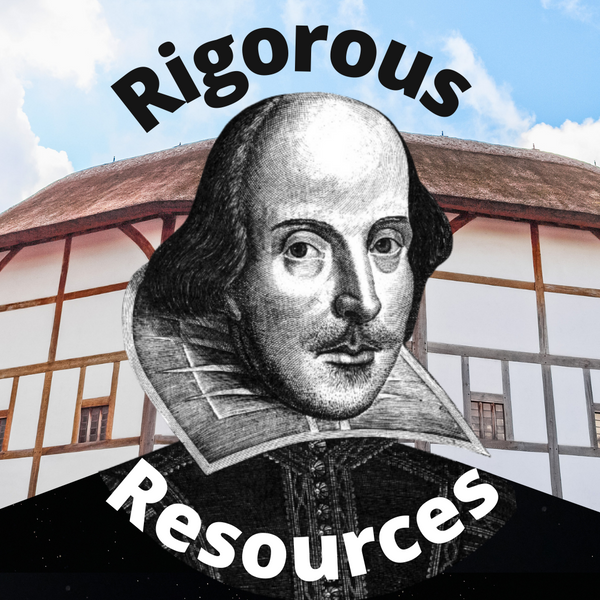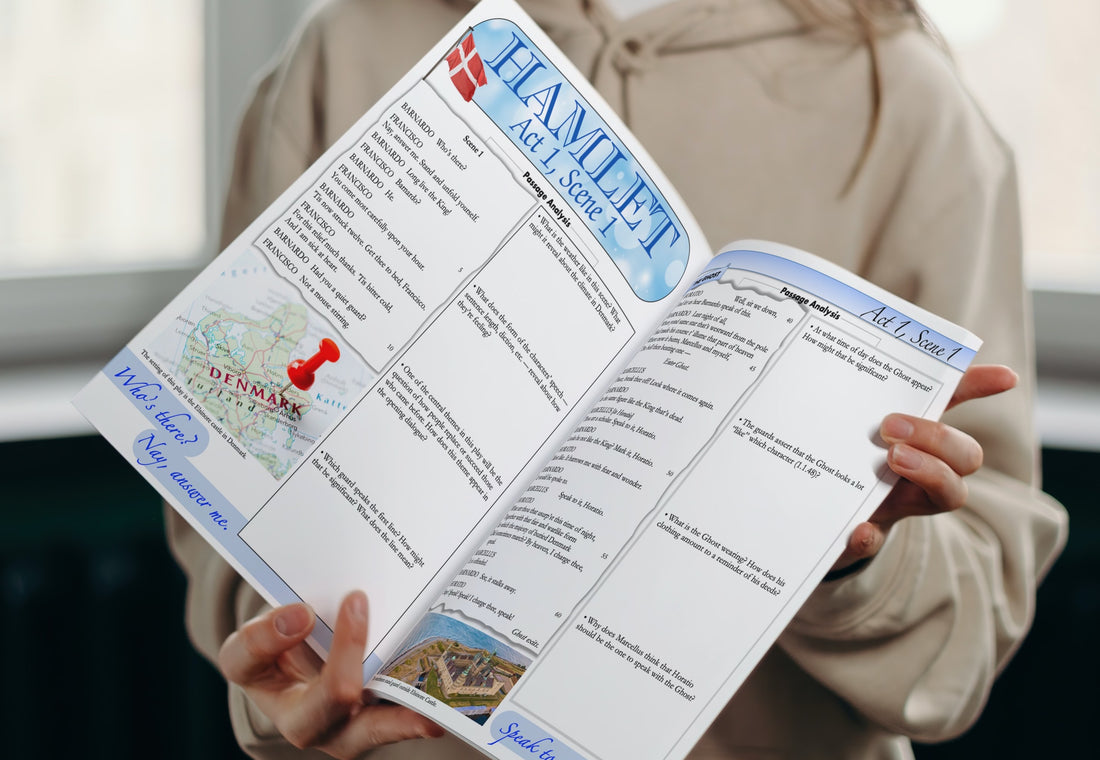Planning to teach William Shakespeare's Hamlet? Despite being one of Shakespeare’s most widely read plays, Hamlet presents challenges for anyone who seeks to interpret it. That may be why T. S. Eliot referred to Hamlet as “the Mona Lisa of literature." By comparing the play to Leonardo’s painting, Eliot suggested that there is something enigmatic about Hamlet that — like the indecipherable smile of Mona Lisa — keeps readers returning to it.
Psychoanalytic theorist Ernst Jones similarly referred to the play as “the Sphinx of modern literature,” invoking not only its riddlesome nature but also its connection to Sophocles’s Oedipus Rex.
Because Hamlet is a notoriously difficult play, I prepare students for the text by having them read and discuss a handout focused on some of the play's most prominent themes. Here are some of the themes addressed in the handout....

I. Parent-Child Relationships: Duty vs. Desire
Hamlet is frequently taught in high schools because it deals with issues relevant to adolescents making the transition into adulthood. One of the most important themes explored by the play is parent-child relationships. Are parents justified in imposing expectations on their children even after those children have grown up? Are grown children obliged to protect the honor of their parents? What happens when a child decides to embrace values which are different from the parents’ values?
Shakespeare may have been moved to ask such questions after his own father passed away in 1601 — the same year in which he would write Hamlet. The death of his father seems to have provoked Shakespeare to reflect upon the long shadow that parents sometimes cast over their children.
At the same time, the death of his father may have impelled the playwright to meditate on the status of the dead, and to ponder what happens to the “soul” after death. One of the first characters that we’ll encounter in the play is the ghost of Hamlet’s deceased father. So one of the first questions invoked by the play is: What might the ghost represent? How does the play amount to more than a ghost story?
The full title of Shakespeare’s play is The Tragical History of Hamlet, Prince of Denmark. Although this title is often foreshortened to the name of the protagonist, what might the full title suggest about the content of the play?
The full title reminds audiences that the protagonist is at once an individual (the bearer of a proper name), a family member (the son of two parents) and a dignitary (the prince of a nation-state). As we’ll see, Hamlet experiences a conflict between the duties incumbent to these different roles.
The play raises the following questions: How should a person act when his personal desires come into conflict with his obligations to his parents? How should a person act when what’s expected of him as a dutiful son comes into conflict with what’s expected of him as a dutiful citizen or good samaritan?

II. Modern Self-Consciousness
Yet if this play focuses on how Hamlet responds to parental expectations, it also explores the expectations which Hamlet sets for himself. For the protagonist engages in constant reflection about who he is and how he should act. Indeed, what has made Hamlet the most closely studied of Shakespeare’s plays is the extent to which Hamlet questions and doubts himself. All of Hamlet’s major soliloquies amount, paradoxically, to debates between a divided self.
The famous soliloquy in the third act, “To be or not to be,” has become the literary hallmark of modern self-consciousness. Why does Shakespeare construct his protagonist in this way? What might the playwright be trying to say about the conditions of modern life?
A soliloquy is a speech delivered when a character is alone on stage. One of the reasons why Hamlet’s soliloquies are so pleasurable to read is that his character is extremely intelligent, articulate, and quick-witted. Another reason why the soliloquies are interesting to read is that Hamlet enjoys exploring the multiple meanings of words. Like a modern-day psychoanalyst, Hamlet seems to believe that a slip of the tongue or an accidental pun can reveal a character’s veiled — or subconscious — intentions. Nor does he exempt himself from such scrutiny. Hamlet is one of the first literary characters to reflect critically upon his own words and actions, examining them for hints of subconscious motives.

III. Hamlet’s Hesitation
It is no accident that Hamlet is Shakespeare’s longest play. For the protagonist’s tendency to engage in self-reflection exerts a shaping influence on the play’s form. Hamlet’s inability to escape from the claims of the past keeps him locked in a slow-moving and densely layered present — and it lends the play a temporal structure which is non-linear, recursive, perhaps even cyclical.
Terence Hawkes has observed that, like its protagonist, the play moves “only unwillingly and haltingly forward, constantly, even as it does so, looking over its own shoulder.” Noting that the play features a number of slow-motion “action replays,” Hawkes observes that “this serves to pull back against any ‘forward’ progressive movement which it might otherwise appear to instigate.”
The first four acts of Hamlet are full of the protagonist’s soliloquies. Because Shakespeare took great care when composing these soliloquies, you’ll want to devote some extra time to reading and reflecting on them. But the fifth and final act of Hamlet will not contain a single soliloquy. Why is that? Has the protagonist found answers to the questions that he had been debating? If Hamlet has finally made up his mind, how does that change the play’s form?
IV. Revenge Tragedy
Shakespeare wrote Hamlet at a time when the “revenge tragedy” had become a popular genre on the Renaissance stage. But while Hamlet qualifies as a revenge tragedy, there are many ways in which the play resists the genre conventions of revenge tragedy. For example, the traditional revenge tragedy was characterized by a swift, linear, action-driven plotline. But in Hamlet, the protagonist’s proclivity to think before he acts has the effect of slowing down the action, turning the play into an inward-facing, psychological drama.
Thus, just as Hamlet reflects critically on the life-plot that he finds himself caught up in, Shakespeare seems to resist the conventions of the very genre in which he is writing. What is the playwright’s message about the mindset which motivates revenge? Does the eye-for-an-eye logic which underpins revenge amount to a legitimate form of justice? Finally, what is Shakespeare using his play to say about the genre of revenge tragedy?

V. A Play within the Play
A technique that Shakespeare employs in a number of his plays is to stage a miniature “play-within-the-play.” Hamlet is the play in which this device gets used most explicitly. The protagonist hires a troupe of actors and has them perform a play for his friends and family. This play-within-the-play takes place in the very middle of Hamlet — in Act 3, Scene 2 — and becomes the device on which the plot will pivot.
This meta-theatrical scene gives Shakespeare a chance to explore the functions of theater. That is, the play-within-the-play offers Shakespeare an opportunity to examine whether literary texts or fictional performances have the power to disclose truths about the real world — or to move people to take action within the real world. So here is one last question for you to consider: What are Shakespeare’s conclusions about the functions of theater in modern society?

Teach It Today!
Save yourself dozens of hours of prep time while motivating students to be highly engaged by grabbing this Complete Teaching Unit on Hamlet. You'll use it for years to come!


2 comments
Excellent analysis of themes in Hamlet!
I agree that Hamlet is Shakespeare’s most enigmatic play — and this is a brilliant analysis of how the psychology of the protagonist is inextricably related to the play’s form. I can’t wait to check out your teaching materials on Shakespeare. Thank you for putting so much thought into the plays!